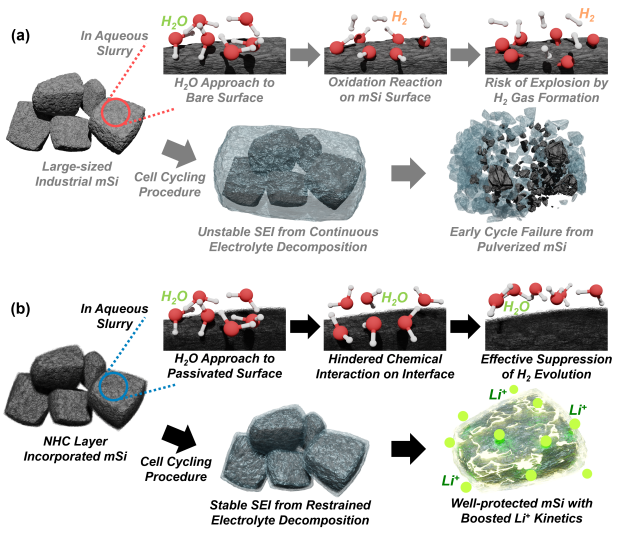
연구
Research Outcome
미래를 창조하는 포스텍 화학공학과
Interfacial Engineering Strategy to Avoid Oxidation Reaction and Boost Charge Transport Kinetics of Microparticle Silicon Larger Than 5 μm for Stable Full Cell Lithium-Ion Battery
- Title of paper
- Interfacial Engineering Strategy to Avoid Oxidation Reaction and Boost Charge Transport Kinetics of Microparticle Silicon Larger Than 5 μm for Stable Full Cell Lithium-Ion Battery
- Author
- [김원배 교수님 연구실] 리튬이온 배터리용 마이크로 실리콘의 안정성 및 전하 이동 효율 향상을 위한 계면 코팅 연구
- Publication in journal
- Batteries Supercaps 2025, e202500037
- Publication date
- 20250506

Abstract
Demand for advanced energy storage technologies has spurred interest in lithium-ion batteries (LIBs) with silicon (Si) anodes promising higher energy-density due to superior theoretical capacity. However, Si anodes face challenges such as significant volumetric expansion, low electrical conductivity, and safety concerns due to gas evolution. This study addresses these issues by introducing nitrogen-doped hard carbon (NHC) layer onto microparticle silicon (mSi, ≈5 μm) using scalable wet-chemical coating technique followed by optimal carbonization. The NHC layer successfully suppresses hydrogen (H2) gas evolution by effectively passivating interface to deactivate oxidation reaction. Electrochemical evaluations demonstrate that the NHC layer induces effective solid electrolyte interphase, improves lithium-ion (Li+) diffusion kinetics, and mitigates volumetric expansion of mSi anodes, thereby reducing electrolyte decomposition and enhancing cycling stability. In practical coin-type full cell systems, mSi@NHC-700-20 cell paired with LiNi0.65Co0.15Mn0.20O2 cathode exhibits superior areal capacities over 0.85 and 0.84 mAh cm−2 after 300 cycles at 1 C/0.5 C and 3 C/3 C charge/discharge rates, with ultrastable capacity retention at decay rates of 0.24 % and 0.22 %, respectively. This scalable coating strategy effectively bridges the gap between laboratory-scale research and industrial applications, positioning mSi@NHC anode as a highly promising solution for high-energy-density LIBs in advanced energy storage systems.



